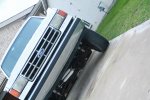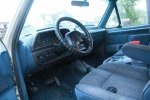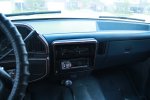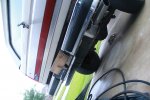yo,
No Start, but Cranks and or Misfire, etc.; Thick Film Ignition (TFI) Testing, Overview & Diagrams; "...
Part I; In This Fast Test you'll be able to pinpoint the problem to the Ignition Control Module or the Ignition Coil or the Profile Ignition Pickup Sensor (PIP Sensor) in four easy test steps. This test will only help you in a Cranks but Does Not Start Condition. So then, before starting the tests, it's critical that you have checked and verified that there's NO SPARK present at the Ignition Coil. Why? Well, because if the Ignition Coil is sparking, it would be a clear indication that it and the Ignition Coil and the Crankshaft Position Sensor (PIP Sensor), if equipped, are working.
This article applies to both the Gray colored Ignition Control Module and the Black colored Ignition Control Module. The Gray colored Ignition Control Module is called the Push Start Module and the Black colored Ignition Control Module is called the Computer Controlled Dwell Module. These ignition control modules are not interchangeable. If you need the tests for the Ford Fender Mounted Ignition Control Module (ICM),
click here.
How Does the Ignition Control Module Work? Here's a little background information to help you diagnose this no spark condition. In a nutshell, when the system is working properly, at CRANK-UP and at all engine speeds, the Ignition Control Module controls the Ignition Coil. How? This is primarily done thru' the Profile Ignition Pickup Sensor Signal which is received by the Ignition Control Module (and also the ECM). The Ignition Control Module (ICM) upon receiving this signal, starts switching the Ignition Coil's Ground On and Off. As you may already know, it's this action that makes the Ignition Coil spark away. The Profile Ignition Pickup Sensor signal (more commonly called the PIP Signal) is critical for the Ignition Control Module to start sparking the Ignition Coil at START UP and at all engine speeds. The Profile Ignition Pickup Sensor is a Hall Effect type Crankshaft Position Sensor and produces a digital (On/Off) signal that can be seen with an LED or an oscilloscope. On an oscilloscope, it produces a digital square waveform. This sensor is located in the Distributor.
What Tools do I Need for the Ignition Module Test? There are several ways to test this Ignition Control Module. An oscilloscope is the best way to check all of the input and output signals but it's not the only way. I'll show you just how. Anyway, if you have access to an oscilloscope, I have included photos of what the waveforms should look like. Whether you use a multimeter or an Oscilloscope, you'll be able to successfully diagnose this NO START CONDITION! So, here's the basic list: An LED Light. Test Light. Multimeter. A cheapie one will do. Repair Manual. For whatever other information this article does not cover. Helper. To help you crank the engine while you observe the LED light (or Test Light or Multimeter). By the way, you don't need an Automotive Scan Tool for any of these tests. We'll first check for the basics like Battery voltage and Engine Ground to the Ignition Control Module. Then we'll test the Ignition Coil Switching Signal that the Module generates in action and from the results you get you'll be able to pinpoint the problem to the Ignition Control Module (ICM) or the Ignition Coil or the Profile Ignition Pickup (PIP) Sensor or completely eliminate these as the cause of the No Start Condition.
IMPORTANT- All of the tests are ON CAR TESTS, do not remove the Ignition Control Module Assembly from the vehicle (all of the figures show the Module Assembly off of the vehicle but this is just for illustration purposes only). Also, the Battery must be in a fully charged condition for all tests in this article.
And lastly, this Fast Test only tests for a NO SPARK / No Start Condition. TEST INFO Circuit Descriptions; Here are brief descriptions of the circuits that we'll be testing. You'll notice that there are no wire color descriptions. This is intentional. The color of the wires in the illustration will not match the ones on your vehicle. The good news is that no matter what color the wires are (on the vehicle), the circuit descriptions DO NOT CHANGE. You will be able to successfully diagnose this NO START CONDITION with this information.
IMPORTANT- It will be necessary to test some of these circuits while the engine is being cranked. Be careful, use common sense and take all necessary safety precautions. Ignition Control Module Connector; 1- Profile Ignition Pickup (PIP) Signal. 2- Spout. 3- 12 V at START. 4- 12 Volts (gray module) or IDM circuit (black module). 5- Ignition Coil Control Signal. 6- Ground. TEST 1 Checking for Power (12 V); We'll begin by checking that the Ignition Control Module is receiving 12 volts. I recommend using a wire piercing probe to accomplish all of the tests in this article. (click here to see a picture of this tool). Whatever method you use, the key here is to be careful. Remember to use common sense and take all safety precautions.
IMPORTANT- The Ignition Coil, Ignition Control Module and the PIP Sensor receive 12 Volts from the same circuit. So if you test one, you test the others. 1 Put the multimeter in VOLTS DC mode. 2 It's not necessary to disconnect the Ignition Control Module (ICM). You'll probe the number 4 circuit of the Ignition Control Module Connector. 3 With the RED multimeter test lead and a suitable tool, probe the number 4 circuit wire of the Connector. 4 With the BLACK lead of the multimeter probe the BATT (-) NEGATIVE terminal. 5 Turn Key On with the Engine Off. Your Multimeter should register 12 Volts DC. CASE 1 If the Multimeter registered 12 Volts DC, All is good in the neighborhood,
GO TO TEST 2. CASE 2 If the Multimeter DID NOT register 12 Volts DC, You must find out why you're missing this voltage. Without this voltage the Module, Ignition Coil, and the PIP Sensor will not work. TEST 2 Testing the Ground Circuit; Here we'll check that the Ignition Control Module (ICM) is receiving a good GROUND. This is done thru' the number 6 circuit of the Igntion Module Connector. 1 Put the multimeter in VOLTS DC mode. 2. With the BLACK multimeter test lead and a wire piercing probe, probe the Ignition Module Connector's number 6 circuit wire. 3 With the RED lead of the multimeter probe the BATT (+) POSITIVE terminal. Your Multimeter should register 12 Volts DC. CASE 1 If the Multimeter registered 12 Volts DC, All is good in the neighborhood, GO TO TEST 3. CASE 2 If the Multimeter DID NOT register 12 Volts DC, This means there is open in this circuit. Without this ground the Ignition Module will not function. Repair the circuit.
TEST 3 Ignition Coil Switching Signal; Now that you have verified the basics, in this test you're gonna' verify that the Ignition Control Module (ICM) is activating the Ignition Coil. Here you're going to use an LED test tool. Click here for a picture of this tool and how to make it. You can also use a Test Light for this test. Use an appropriate tool to pierce the wire and attach the LED test tool (to this tool). Be careful and use all necessary precautions. By the way, in case you want to see a more specific Ford Ignition Coil test, I’ve written one for troubleshootmyvehicle.com and you can see
it here: Ford Ignition Coil Test.
1 Connect the RED wire of the LED to the Battery Positive Terminal.
2 Connect the BLACK wire of the LED to the number 5 circuit of the Ignition Control Module Connector
3 Have an assistant crank the engine. the LED test tool (or Test Light) should blink on and off as the engine is being cranked. Did this occur? CASE 1 The LED Light blinked On and Off as the engine was cranking, This means that the Ignition Control Module is triggering the Ignition Coil. So then, the Ignition Control Module is good and can been eliminated as the cause of the NO START condition. By a process of elimination, we can assume that the Ignition Coil is faulty and is the source of the NO START condition. Replace the Ignition Coil.
CASE 2 The LED Light DID NOT blink On and Off as the engine was cranking, Re-check all of your connections and retry the test again. If still no light pulses on the test LED, GO TO TEST 4.
TEST 4 Testing the PIP Signal; Here we'll check that the Profile Ignition Pickup Sensor (PIP) is being received by the Ignition Control Module (ICM). The PIP Signal is just Ford’s name for the Crankshaft Position Sensor Signal. Now, in case you’re wondering... the PIP Sensor is located inside the Distributor. This will be achieved by using the same LED test tool.
Click here for a picture of this LED tool and how to make it.
Do not use a Test Light for this test; With a suitable tool and with the key in the Off position, pierce the number 1 circuit wire of the Ignition Control Module Connector. Connect the BLACK wire of LED to the tool that is piercing the wire. Connect the RED wire of the LED to the BATTERY (+) POSITIVE terminal. Have an assistant crank the engine while you observe the LED. The LED should start to blink on and off as the engine is cranked. Is the LED blinking on and off as the engine is cranked? CASE 1 If the LED blinked On and OFF as your helper cranked the engine The Ignition Control Module (ICM) is BAD. Replace the Ignition Control Module. Here’s why: As you’re already aware, the Ignition Control Module needs:
1.) power in the form of 12 Volts.
2.) It needs a good path to ground.
3.) It needs the PIP Signal to start creating the Switching Signal the Ignition Coil needs to start sparking. So, up until this point (in the testing) you have verified that the module does have power, that it does have ground and that it’s not creating a Switching Signal for the Ignition Coil. In this step you have confirmed that the PIP Sensor is generating a PIP Signal (as indicated by a blinking LED light). So, if the Ign. Module is getting power, ground and the PIP Signal (as evidenced by the blinking LED) is has to create a Switching Signal... if it doesn’t, it’s fried. CASE 2 The LED DID NOT blink On and OFF as your helper cranked the engine If you have no pulses, recheck all connections. Try again. If you still have no pulses. The Profile Ignition Pickup Sensor (PIP) is BAD and the cause of this NO START condition. You’ll need to replace the PIP Sensor to solve the No Start No Spark Condition on your Ford (or Mercury or Lincoln) vehicle. As mentioned earlier, the Profile Ignition Pickup (PIP) Sensor is just a Crankshaft Position Sensor located inside the Distributor. This is the Sensor that tells the Ignition Control Module (ICM) when to start activating the Ignition Coil to start Sparking away. So, if this PIP Signal is missing (as indicated by the LED not blinking on and off), the Ignition Control Module will not function..."
SEE Site for Diagrams
Spark Tester, DIY; W/ an old spark plug and cut off the L-shaped tip,& clean up the center electrode and surrounding metal with a bit of sandpaper. Drill a small hole in the thickest part of the metal (where the wrench goes on). Use a metal ***** to attach a length of wire, a couple of feet, to the body of the spark plug. To the other end of the wire, solder or otherwise attach a big alligator clip. Since the tip is cut off, the spark will have to be stronger to jump the wider gap. It is harder for a spark to form in a compressed cylinder so it more accurately represents the spark performance under running conditions. With the engine off, remove the spark plug wire you wish to test from the spark plug. Attach the spark tester to the plug wire and connect the alligator clip to a good ground. Remember that the coil output can give you a very nasty shock, so make sure to wear thick gloves or use a rag to hold the tester, and not to touch the body of the car when the system is energized. Hold the tester away from the car body and use your remote starter switch or have an assistant start the car (or simply turn it over). You should get a healthy bluish white spark from the center post to the side of the spark tester. COIL; If your coil is already off the Bronco, you can bench test your coil. To set up the test, remove one spark plug wire from its plug, then remove the spark plug using a spark plug socket. Next put the spark plug back into the spark plug wire. Be careful not to let anything drop into the empty spark plug hole. Holding the plug wire with insulated pliers, find a spot on the engine that is a good and easily accessible grounding point. Pretty much any exposed metal, including the engine itself, will do. Holding the spark plug wire with your pliers, touch the threaded portion of the spark plug to the grounding point. Have somebody crank the engine with the key, and look for a bright blue spark to jump across the spark plug gap. If you see a nice, bright spark (clearly visible in daylight) your coil is doing its job.







